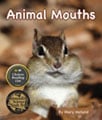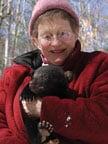| |
Animal Legs  |
Can you smell with your feet? Do you dig your claws into a river’s muddy bank to climb up and bask in the sun? Animals’ legs are different from humans’ in so many ways! Find out why strong talons suit a raptor, or webbing is perfect for water dwellers as author Mary Holland continues her photographic Animal Anatomy and Adaptations series by exploring the ways insects, amphibians, reptiles, birds, and mammals move and explore their world. This nonfiction picture book with a cuddle factor includes a 4-page For Creative Minds section in the back of the book and a 50-page cross-curricular Teaching Activity Guide online. Animal Legs is vetted by experts and designed to encourage parental engagement. Its extensive back matter helps teachers with time-saving lesson ideas, provides extensions for science, math, and social studies units, and uses inquiry-based learning to help build critical thinking skills in young readers. The Spanish translation supports ELL and dual-language programs. The interactive ebook reads aloud in both English and Spanish with word highlighting and audio speed control to promote oral language skills, fluency, pronunciation, text engagement, and reading comprehension. Tap animals and other things that make noise to hear their sounds. Written by Mary Holland
32 pg, 8.5x10, Ages 4-8, Grades K-3, Lexile: NC 1020L, AR: 4.5, F&P: O
| |
|
|
|
|
|
| Keywords: adaptations, feet, legs, movement, |
|
| Animals in the book: backswimmer, caterpillar, green frog, hairstreak, human, mole, painted turtle, praying mantis, red-shouldered hawk, river otter, ruffled grouse, striped skunk, treefrog |
|
| Vetters: Thanks to Roger Wrubel, Sanctuary Director at Mass Audubon’s Habitat Education Center & Wildlife Sanctuary, for verifying the accuracy of the information in this book. |
|
Books in this "Animal Adaptations Series" include:








Reviews:
The design (black text set against a white background, along with numerous photos) makes this selection a good read-aloud option in a science unit covering animal anatomy. - School Library Journal
Although written for the early elementary crowd, the writing is by no means simplistic or childish, and both my 7 and 9 year old boys enjoyed it.
-The Old Schoolhouse Magazine
Author Mary Holland has done an excellent job of introducing young readers to animal legs and the many functions they perform. With easy to understand explanations, she takes children on a journey through the animal world to explore all the various uses of animal legs.
Feathered Quill Book Review
Author/Illustrator Info:

Mary Holland is a naturalist, nature photographer, columnist, and award-winning author with a life-long passion for natural history. After graduating from the University of Michigan's School of Natural Resources, Mary worked as a naturalist at the Museum of the Hudson Highlands in New York state, directed the state-wide Environmental Learning for the Future program for the Vermont Institute of Natural Science, worked as a resource naturalist for the Massachusetts Audubon Society, and designed and presented her own "Knee-High Nature Programs" for libraries and elementary schools throughout Vermont and New Hampshire.
Her children's books with Arbordale include Animal Tracks and Traces, Animal Homes, Otis the Owl, Ferdinand Fox's First Summer (NSTA / CBC Most Outstanding Science Trade Book and Moonbeam Children's Book Award), The Beavers' Busy Year, Yodel the Yearling, Animal Skins, Animal Ears, Animal Tails, Animal Noses, Animal Eyes, Animal Legs, and Animal Mouths (NSTA / CBC Most Outstanding Science Trade Book). Mary's book Naturally Curious: a Photographic Field Guide and Month-by-Month Journey Through the Fields, Woods and Marshes of New England won the 2011 National Outdoor Book Award for the Nature Guidebook category. Naturally Curious Day by Day was published in 2016. Mary lives in Vermont with her lab, Greta. Visit Mary's blog at Naturally Curious with Mary Holland.
|
| |
|